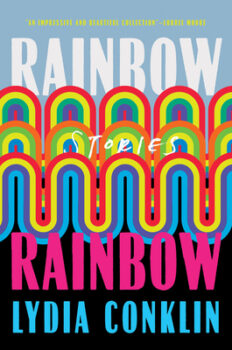 Lori Ostlund’s debut story collection, The Bigness of the World (University of Georgia Press), recently won the Flannery O’Connor Award for Short Fiction, and I can’t help but imagine how O’Connor might react to its stories, full as they are of godless homosexuals scattered across the globe, whereas O’Connor’s work is unapologetically regional and almost dogmatically Catholic. Even with this wide discrepancy in subject matter, Ostlund’s book is one O’Connor might have chosen herself, so similar are their aesthetics. In fact, Ostlund’s characters in many ways resemble the ones that O’Connor is always pushing toward their inevitable moments of grace—stubborn, overeducated folks who value rationality and discretion to the point of personal isolation. It’s a book full of Hulgas from “Good Country People,” except that it would take a Bible saleswoman to seduce them, and they’re all too fussy about language to ever choose a name as unattractive as “Hulga.”
Lori Ostlund’s debut story collection, The Bigness of the World (University of Georgia Press), recently won the Flannery O’Connor Award for Short Fiction, and I can’t help but imagine how O’Connor might react to its stories, full as they are of godless homosexuals scattered across the globe, whereas O’Connor’s work is unapologetically regional and almost dogmatically Catholic. Even with this wide discrepancy in subject matter, Ostlund’s book is one O’Connor might have chosen herself, so similar are their aesthetics. In fact, Ostlund’s characters in many ways resemble the ones that O’Connor is always pushing toward their inevitable moments of grace—stubborn, overeducated folks who value rationality and discretion to the point of personal isolation. It’s a book full of Hulgas from “Good Country People,” except that it would take a Bible saleswoman to seduce them, and they’re all too fussy about language to ever choose a name as unattractive as “Hulga.”
The reason O’Connor might find these stories appealing is because they are not about lesbianism any more than “Everything That Rises Must Converge” is about racism, not about traveling the world any more than “A Good Man Is Hard to Find” is about traveling to Florida. In her best stories, Ostlund, like O’Connor, pushes beyond mere subject matter to describe deeper aspects of the human condition, aspects all of us can recognize, and she does it by employing O’Connor’s “two qualities that make fiction,” as she famously describes in her book of craft essays, Mystery and Manners, the title of which gives away the two qualities she means.
Just as O’Connor’s characters are mostly Southern and have corresponding manners, both good and bad, Ostlund’s characters are mostly Minnesotans, and they have correspondingly Midwestern manners. They are reticent, restrained, practical. These manners are important not because they indicate politeness but because they establish patterns of behavior, standards for the way the characters engage with the world. Without knowing those standards, it would be impossible for readers to interpret the shifts and alterations that come over the characters.
In “A Good Man Is Hard to Find,” for example, O’Connor shows us again and again how shallow the grandmother’s ideas are, how empty and hysterical her words, so when she touches The Misfit’s shoulder and murmurs, “Why you’re one of my babies,” it breaks the pattern, showing us that something in her has shifted, that she has experienced a moment of profound and genuine connection. This wouldn’t be the case if she was always touching people and speaking in a low, controlled voice, or if she sometimes did and sometimes didn’t. A pattern has been established through manners that lets us see the character’s action more clearly.
Ostlund does the same thing. In the title story, for example, the narrator tells us about the woman who used to babysit her and her brother:
We were not used to adults who cried freely or openly, for this was Minnesota, where people guarded their emotions, a tradition in which Martin and I had been well schooled. Ilsa, while she was from here, was not, as my mother was fond of saying, of here, which meant that she did not become impatient or embarrassed when we occasionally cried as well.
In this passage, Ostlund establishes two behavior patterns, the guardedness of the narrator’s family and the relative emotional flamboyance of the babysitter, Ilsa. These traits are dramatized elsewhere in the story and therefore confirmed for the reader. The narrator’s father, for example, wanting his children to understand the nature of his work, hands over his business card, then stares at them impatiently. Ilsa, on the other hand, weeps during her daily walks and belts out Chinese opera.
Knowing the manners of both characters becomes important later in the story, when Ilsa walks the children back to their house, where their father waits for them. During this walk, the children point out a crushed snail, “waiting for her to cry out, ‘Death, be not proud!’ and then to squeeze her eyes shut while allowing us to lead her safely past it.” Because the reader has seen this sort of thing from Ilsa before, the children’s expectations seem reasonable, and so when she “glanced at the crushed bits with no more interest than she would have shown a discarded candy wrapper,” it’s an indication that something is amiss, that something in her has shifted. It also lends gravity to the scene, so that when Ilsa explains that she will “be setting off very soon—really any day now—on long journey,” the reader understands there is more to this statement than it seems. Likewise, when the father greets the children with some bad news and then breaks into tears, the shift from his normal stoicism heightens the scene’s emotional power. If these actions had each belonged to the other character—Ilsa sobbing at the table, the father showing no interest in a crushed snail—the effect would be much different. Only by understanding the characters’ manners can we glimpse their depths.
What makes many of these stories so enjoyable is that Ostlund’s characters bring their Midwestern manners with them to New Mexico and Belize, Spain and Morocco, Indonesia and Malaysia. In “Bed Death,” two women in Malaysia must, on their way to their hotel room, regularly pass a man recovering from a stabbing, and they argue about whether or not they should greet him. “As I prefer to pass my own illnesses without interference,” the narrator explains, “I maintained that we should not ask him to engage in unnecessary politenesses when he so obviously needed his energy for mending.” In “Nobody Walks to the Mennonites,” two women in Belize find a café that is really a private kitchen, and they sit there for hours, afraid of offending someone by leaving. Later, when they’re served dishes of fried rice, they suspect the small chunks of food are recycled from other customers, so they remove them, working through the rice “as though they had lost something of great importance amid the grains.”
Besides the obvious humor, another of O’Connor’s staples, these displaced Midwestern manners create some interesting dynamics. Ostlund’s characters are careful, conscientious people, the type who live in dread of offending anyone, and yet they are continually forced into the possibility of culture clashes. They are also caught between geographical expansiveness and personal hermitry, their willingness to observe the world complicated by an unwillingness to fully engage with it.
The best stories, however, are the ones in which the characters stay home in Minnesota. By comparison, many of the travel stories, though deft and intriguing, don’t seem to amount to much. They are compilations of strange but transitory experiences, and when something meaningful happens—a breakup with a lover, a moment of empathy for a stranger—it is often abrupt and enigmatic and seems similarly transitory, which reduces its impact. But these are minor imperfections that might not even be noticeable if they weren’t stacked alongside stories as stunning as “The Bigness of the World,” “Talking Fowl with My Father,” and “All Boy,” the last of which was selected by Richard Russo for Best American Short Stories 2010.
Part of what makes these stories so successful is that they render what O’Connor calls “mystery.” She never does us the favor of defining this term, but it’s clear from her many references that she’s talking about the fundamental truths of human nature, the laws of existence we can’t explain, the point in a child’s game of why?-why?-why? at which we can only respond, because that’s the way it is. She calls our position on earth a mystery, and free will, and giftedness: Why are we here? What controls our whims? Why do some people possess talents others do not? Certainly there are philosophies that address these questions, but the fiction writer’s job, O’Connor says, is not to explain such mysteries but to make contact with them:
If the writer believes that our life is and will remain essentially mysterious, [. . .] then what he sees on the surface will be of interest to him only as he can go through it into an experience of mystery itself. His kind of fiction will always be pushing its own limits outward toward the limits of mystery [. . .] Such a writer will be interested in what we don’t understand rather than in what we do.
For O’Connor, who describes her faith as “the light by which I see,” these mysteries have a decidedly religious tincture, but she doesn’t pretend her faith holds the solutions. It’s the unexplainable she’s concerned with, the most basic elements of the human nature, and that’s why she transcends her subject matter and touches “mystery.”
We can see this dynamic at play in the climax of “A Good Man Is Hard to Find,” when the grandmother recognizes a bond with The Misfit, a man who has just murdered her family. The scene leading up to this moment is unequivocally religious—the grandmother is trying to save herself by invoking Jesus while The Misfit expresses his deep frustration that he can’t witness Jesus’s miracles and therefore believe in his divinity. He is so frustrated that he is on the verge of tears, and this vulnerability allows the grandmother to see “that she is responsible for the man before her and joined to him by ties of kinship which have their roots deep in the mystery she has been merely prattling about so far,” as O’Connor explains in Mystery and Manners. This is the moment she touches his shoulder and murmurs, “Why you’re one of my babies.”
This is an incredibly complex story, and there’s a lot more going on in this moment than I can describe here, but primary among them is the grandmother’s demonstration of basic human empathy, the ability to feel someone else’s pain, and human interconnectedness, the sense that we are all responsible for one another. These elements can certainly be interpreted along religious lines, but they don’t have to be; they are universal mysteries all of us can recognize. Why do we suffer when we witness the suffering of others? Why does it feel as though we’re all in this thing together? Well, that’s just the way it is, isn’t it? O’Connor isn’t attempting to explain the phenomenon, just to render it accurately.
Same goes for Ostlund. If we return to the title story, we see that when Ilsa tells the children she’ll soon set off on a long journey, she’s most likely euphemizing her impending death, which means that Ostlund, like O’Connor, has placed her character on the very brink of that great mystery. It’s in this context that the protagonist asks Ilsa if she’s going to see the ocean on her journey, because “I could not imagine anything more terrifying than the ocean.” The child doesn’t understand Ilsa’s euphemism, but we do, so when Ilsa answers yes, the ocean “accumulates meaning,” as O’Connor would put it—we recognize the metaphorical implications, the association the author is making between the ocean and death, the vastness and emptiness and, for a Minnesotan, foreignness of both, and the terror these qualities can evoke. Ilsa afterward encourages the children to see the ocean so that they can understand the bigness of the world, and when they ask why they must understand such a thing, she replies, “there have been times in my life when the bigness of the world was my only consolation.” Because the ocean has taken on larger associations, this line of reasoning lends larger associations to “the world,” the definition of which can be “everything that exists; the universe; the macrocosm,” according to Webster’s. This may seem to smack of religion, but it’s only because Ostlund is pointing us toward ultimate questions: How big is the world? How can we comprehend such a thing, let alone witness it? Why must we die, and why must we lose the people we care about? How can something so terrifying also console us? Ostlund’s purpose isn’t to answer these questions, it’s to let us experience them, to carry us toward their mysteries.
She carries us that direction again in “All Boy.” She renders an eleven-year-old boy, Harold, who is proper and curious, and again, she does it with manners, showing us a character who reads widely and looks up words in the dictionary and asks if he may watch—he’s careful to use “may” rather than “can”—while the babysitter has her toenails shorn off with a device that resembles industrial-strength wire clippers. These manners give the impression of a boy who trusts that life has only innocuous and rewarding secrets to reveal, even as the action turns darker. When a babysitter locks him in the closet, he doesn’t mind, using the opportunity to read by flashlight and eat Life Savers, enjoying the discovery of each new flavor. When an acquaintance uses the word “fag,” he looks up its definition and promptly uses the new word at the dinner table.
At the end of the story, however, Harold’s father leaves the family, and through this action Harold stumbles upon the world to which he’s been blind, one that contains sadness and even menace. This is what Harold reacts to, asking his father if his departure means that nobody will check the windows and doors before bedtime anymore. The thought terrifies him, and the story ends with Harold longing to be locked in the closet, in the dark, both terms having metaphorical resonance here, “in the closet” referring to undisclosed information, especially about sexuality, and “in the dark” to ignorance. Harold now longs for these, preferring innocence over curiosity, because the unknown, which was at first something he believed he could conquer with safety and amusement, has become sinister.
This is where the story touches mystery, where Ostlund makes contact with a basic, unexplainable truth: why must knowledge spoil innocence? This is territory the Bible covers, too, of course. Adam and Eve eat from the tree of knowledge and are cast out of Eden, but does that story answer the question any better Ostlund’s? Because God said so, the Bible story teaches, which is really just another way of saying, Because that’s the way it is. We don’t know why. It’s a fundamental truth, a mystery, and therefore something anyone can recognize and appreciate, no matter what her religious bent. That’s why these stories deserve O’Connor’s laudation, even if it can come only in the form of the award that is named for her.
Further Links and Resources
- Richard Russo curated a segment on what he considers the Best Stories of 2010 on NPR’s All Things Considered. Hear Lori Ostlund read an excerpt from her short story “All Boy” on the program, click here for both the audio and a transcript.
- Read Aimee Benders brief, but nonetheless great, piece on the enduring importance of O’Connor’s Mystery and Manners from NPR’s “You Must Read This” series of writers on the books they love.
- Read Ostlund’s essay for the Emerging Writers Network on working with two editors – Carolyn Kuebler of the New England Review and Nancy Zafris of the University of Georgia Press, who selected The Bigness of the World for the Flannery O’Connor Prize.
- Buy a copy of The Bigness of the World from Powell’s Books.






